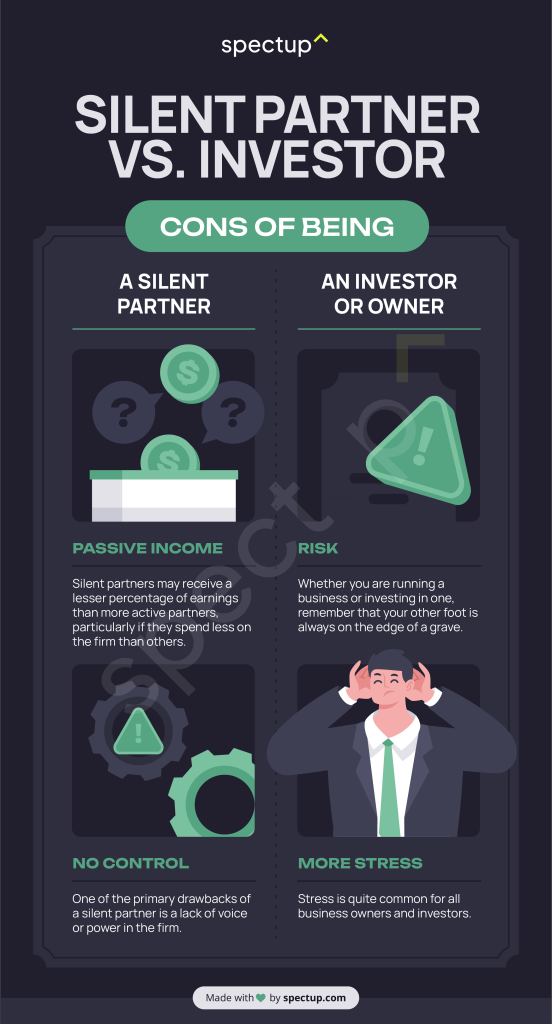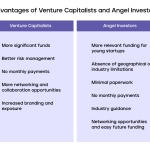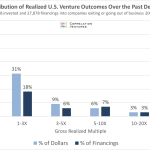What is the Difference Between Angel Investors Venture Capitalists and Silent Partner Investors

When it comes to funding a business, understanding the nuances between different types of investors is crucial. Angel investors, venture capitalists, and silent partner investors each play distinct roles in the financial ecosystem, offering unique advantages and expectations. Angel investors are typically high-net-worth individuals who provide capital in exchange for equity, often during a startup's early stages. Venture capitalists, on the other hand, represent firms that invest larger sums in high-growth companies, usually in exchange for significant control. Silent partners contribute funds without active involvement in operations, focusing solely on financial returns. This article explores the key differences between these investor types, helping entrepreneurs make informed decisions about their funding strategies.
- What is the Difference Between Angel Investors, Venture Capitalists, and Silent Partner Investors?
-
Understanding the Key Differences Between Angel Investors, Venture Capitalists, and Silent Partner Investors
- 1. What is an Angel Investor and How Do They Operate?
- 2. What Defines a Venture Capitalist and Their Investment Strategy?
- 3. Who Are Silent Partner Investors and What Role Do They Play?
- 4. How Do Investment Amounts Differ Among Angel Investors, Venture Capitalists, and Silent Partners?
- 5. What Are the Risk and Return Expectations for Each Type of Investor?
-
Frequently Asked Questions (FAQs)
- What is the main difference between angel investors and venture capitalists?
- How do silent partner investors differ from angel investors and venture capitalists?
- What level of involvement do angel investors and venture capitalists have in a business?
- What are the typical investment amounts for angel investors, venture capitalists, and silent partners?
What is the Difference Between Angel Investors, Venture Capitalists, and Silent Partner Investors?
Angel investors, venture capitalists, and silent partner investors are three distinct types of investors who provide funding to businesses, but they differ in their investment approach, level of involvement, and risk tolerance. Understanding these differences is crucial for entrepreneurs seeking the right type of funding for their ventures.
See Also What is Difference Between Angel Investor and Venture Capitalist
What is Difference Between Angel Investor and Venture Capitalist1. Who Are Angel Investors?
Angel investors are typically high-net-worth individuals who invest their own money into early-stage startups or small businesses. They often provide seed funding or initial capital to help businesses get off the ground. Angel investors are known for taking higher risks in exchange for equity ownership in the company. They may also offer mentorship and industry connections to help the business grow.
2. What Defines Venture Capitalists?
Venture capitalists (VCs) are professional investors who manage pooled funds from institutions or wealthy individuals. They invest in high-growth potential startups or companies that are in the expansion phase. Unlike angel investors, VCs typically invest larger amounts of capital and take a more hands-on approach, often securing a board seat to influence business decisions. Their goal is to achieve significant returns through an exit strategy, such as an IPO or acquisition.
See Also How Much in Returns Do Venture Capitalists Generally Expect for Their Investment in a Startup
How Much in Returns Do Venture Capitalists Generally Expect for Their Investment in a Startup3. What Are Silent Partner Investors?
Silent partner investors, also known as limited partners, provide capital to a business but do not participate in its day-to-day operations or management decisions. They are passive investors who earn a share of the profits based on their investment. Silent partners are ideal for entrepreneurs who want financial support without giving up control of their business. However, they may still have a legal stake in the company.
4. Key Differences in Investment Size
The amount of capital provided by these investors varies significantly. Angel investors usually invest smaller amounts, ranging from $25,000 to $100,000, while venture capitalists invest millions of dollars in established startups with proven potential. Silent partners can invest any amount, depending on the agreement, but their contributions are often less than VCs.
See Also What Do Venture Capitalists Look for When Deciding to Invest in an Idea and a Team
What Do Venture Capitalists Look for When Deciding to Invest in an Idea and a Team5. Level of Involvement and Risk
Angel investors and venture capitalists are actively involved in the businesses they fund, offering guidance and leveraging their networks. In contrast, silent partners remain detached from operations. In terms of risk, angel investors take the highest risk due to the early-stage nature of their investments, while VCs mitigate risk by investing in more mature companies. Silent partners assume moderate risk, as their returns depend on the business's performance.
| Investor Type | Investment Size | Involvement Level | Risk Level |
|---|---|---|---|
| Angel Investors | $25,000 - $100,000 | Active | High |
| Venture Capitalists | $1M+ | Very Active | Moderate to High |
| Silent Partners | Varies | Passive | Moderate |
Understanding the Key Differences Between Angel Investors, Venture Capitalists, and Silent Partner Investors
1. What is an Angel Investor and How Do They Operate?
An angel investor is typically an individual who provides capital for a business startup, often in exchange for convertible debt or ownership equity. These investors are usually high-net-worth individuals who invest their own money into early-stage companies. Unlike venture capitalists, angel investors are not part of a firm but act independently. They often bring not only financial support but also mentorship and industry expertise to the table. Angel investors are known for taking higher risks compared to other types of investors, as they invest in companies that are often in their infancy stages and may not yet have a proven track record.
See Also What is the Reputation of the Vc Fund New Enterprise Associates (Nea)
What is the Reputation of the Vc Fund New Enterprise Associates (Nea)2. What Defines a Venture Capitalist and Their Investment Strategy?
Venture capitalists (VCs) are professional investors who manage pooled funds from various sources, such as pension funds, endowments, and wealthy individuals. They invest in startups and small businesses with high growth potential, usually in exchange for equity stakes. Unlike angel investors, venture capitalists typically invest larger amounts of money and are involved in later-stage funding rounds. They also play a more active role in the companies they invest in, often taking board seats and influencing strategic decisions. VCs are known for their rigorous due diligence processes and their focus on scaling businesses rapidly to achieve significant returns on investment.
3. Who Are Silent Partner Investors and What Role Do They Play?
A silent partner investor, also known as a limited partner, is someone who invests capital into a business but does not take an active role in its day-to-day operations or management. These investors are primarily focused on providing financial backing and expect a return on their investment through profit sharing or dividends. Silent partners are often passive investors who prefer to remain in the background, allowing the active partners or management team to run the business. This type of investment is common in partnerships and small businesses where the investor seeks to minimize their involvement while still benefiting from the business's success.
4. How Do Investment Amounts Differ Among Angel Investors, Venture Capitalists, and Silent Partners?
The investment amounts vary significantly among these three types of investors. Angel investors typically invest smaller amounts, ranging from $25,000 to $100,000, although some may invest up to $1 million or more. Venture capitalists, on the other hand, usually invest much larger sums, often starting at $1 million and going up to tens of millions of dollars, depending on the stage of the company and its growth potential. Silent partner investors can invest anywhere from a few thousand dollars to millions, depending on the size of the business and the agreement terms. The key difference lies in the scale of investment and the level of involvement each type of investor has in the business.
5. What Are the Risk and Return Expectations for Each Type of Investor?
The risk and return expectations vary widely among angel investors, venture capitalists, and silent partners. Angel investors are known for taking on high-risk investments in early-stage companies, with the potential for high returns if the company succeeds. However, the likelihood of failure is also high, making this a speculative investment. Venture capitalists also take on significant risk, but they mitigate it by investing in later-stage companies with proven business models and higher chances of success. They expect substantial returns, often aiming for 10x or more on their investment. Silent partner investors generally seek lower-risk opportunities with steady returns, often through profit-sharing agreements or dividends. Their returns are typically more modest but more predictable compared to the other two types of investors.
Frequently Asked Questions (FAQs)
What is the main difference between angel investors and venture capitalists?
Angel investors are typically individuals who invest their own money into early-stage startups, often in exchange for equity. They usually provide smaller amounts of capital compared to venture capitalists and are more involved in mentoring and guiding the founders. On the other hand, venture capitalists are professional investment firms that manage pooled funds from various investors. They invest larger sums of money, usually in more established startups, and focus on achieving high returns through scaling the business.
How do silent partner investors differ from angel investors and venture capitalists?
Silent partner investors are individuals or entities that provide capital to a business but do not take an active role in its day-to-day operations or decision-making. Unlike angel investors, who often offer mentorship, or venture capitalists, who may demand significant control, silent partners remain in the background. Their primary contribution is financial, and they typically receive a share of the profits without influencing the company's strategic direction.
What level of involvement do angel investors and venture capitalists have in a business?
Angel investors are often hands-on and actively participate in the growth of the startup by offering advice, networking opportunities, and industry expertise. They may also take a seat on the board of directors. In contrast, venture capitalists tend to focus on strategic oversight and may require a more formal role in decision-making, such as board representation, to ensure the company aligns with their investment goals. Both types of investors seek to add value beyond just funding, but their level of involvement varies significantly.
What are the typical investment amounts for angel investors, venture capitalists, and silent partners?
Angel investors usually invest smaller amounts, ranging from $25,000 to $100,000, though some may go up to $1 million. Venture capitalists, on the other hand, invest much larger sums, often starting at $1 million and going up to tens or even hundreds of millions, depending on the stage of the company. Silent partners can invest varying amounts, but their contributions are generally more flexible, as they are not tied to specific funding rounds or milestones like angel investors and venture capitalists.
Leave a Reply

Our Recommended Articles